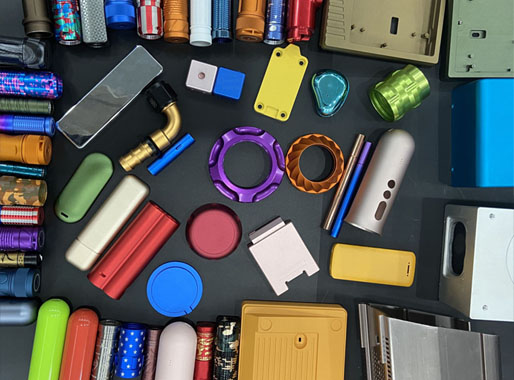15 years one-stop China custom CNC machining parts factory

Hey there I’m VMT Sam!
With 25 years of CNC machining experience we are committed to helping clients overcome 10000 complex part-processing challenges all to contribute to a better life through intelligent manufacturing. Contact us now
 111 |
Published by VMT at Apr 08 2024
111 |
Published by VMT at Apr 08 2024
In the field of CNC machining, surface treatment, especially the formation of oxide films, plays a crucial role in enhancing the corrosion resistance, wear resistance, and aesthetics of parts. However, the color and stability of oxide films are often influenced by various factors, leading to poor surface quality of parts. This article delves into how to improve the color and stability of oxide films on precision CNC parts, meeting the continuously rising demands for product quality.

I. Principles and Factors Affecting Oxide Film Formation
Oxide films are thin and dense oxide layers formed on the metal surface through chemical reactions. This layer not only protects the metal substrate from corrosion but also improves the friction performance of the parts. However, the color and stability of oxide films are influenced by various factors, including metal type, surface condition, and oxidation treatment process conditions.
II. Methods to Improve Oxide Film Color
Optimize Oxidation Treatment Process:
By adjusting parameters such as temperature, time, and electrolyte concentration during the oxidation process, precise control over the color of oxide films can be achieved. For instance, increasing the oxidation temperature appropriately can promote oxidation reactions, resulting in more vibrant oxide film colors, while prolonging the oxidation time can make the oxide film thicker and more uniform in color.
Select Appropriate Electrolyte:
The choice of electrolyte has a significant impact on the color of oxide films. Different types of electrolytes produce oxide films of different colors. Therefore, selecting the appropriate electrolyte according to the usage requirements and aesthetic needs of the parts is key to improving oxide film color.
Add Coloring Agents:
Adding coloring agents to the electrolyte can produce specific colors of oxide films during the oxidation process. By adjusting the type and concentration of coloring agents, precise control over the color of oxide films can be achieved.
III. Measures to Enhance Oxide Film Stability
Improve Metal Surface Condition:
The cleanliness and smoothness of the metal surface significantly affect the stability of oxide films. Therefore, thorough cleaning and polishing of the metal surface should be conducted before oxidation treatment to remove oil, impurities, and oxide scale.
Enhance Post-Treatment Processes:
Post-treatment processes such as sealing treatment and passivation treatment can further enhance the stability of oxide films. Sealing treatment can fill the micro-pores in the oxide film, improving its density, while passivation treatment can form a more stable compound on the surface of the oxide film, enhancing its corrosion resistance.
Strictly Control Oxidation Treatment Environment:
Factors such as humidity, temperature, and cleanliness of the oxidation treatment environment will affect the quality of oxide films. Therefore, during the oxidation treatment process, environmental parameters should be strictly controlled to ensure the stability and reliability of oxide film formation.
IV. Practical Applications in CNC Machining Factories
CNC machining factories have accumulated rich practical experience in improving oxide film color and stability. By employing advanced oxidation treatment equipment and technology, combined with meticulous process control, factories can produce CNC precision parts with excellent oxide film quality. Additionally, factories emphasize collaboration with research institutions and universities, continuously introducing new technologies and materials to drive innovation in oxidation treatment technology.

V. Conclusion and Future Outlook
Improving the color and stability of oxide films in CNC machined parts is a complex system engineering task that requires comprehensive consideration of materials, processes, and environmental factors. Through measures such as optimizing oxidation treatment processes, selecting appropriate electrolytes, adding coloring agents, and enhancing post-treatment processes, the quality and stability of oxide films can be effectively enhanced. With the continuous advancement of technology and process improvement, it is believed that we can produce even higher-quality and more aesthetically pleasing CNC precision parts to meet the growing market demand.
Furthermore, for CNC machining factories, in addition to focusing on oxide film quality, attention should also be paid to improving production efficiency, reducing production costs, and strengthening environmental protection measures. By introducing advanced CNC machining equipment and automated production lines, achieving efficient and precise machining processes; optimizing production processes and management models to reduce production costs and resource consumption; and strengthening environmental awareness and investment to ensure green and sustainable production processes.
Looking ahead, with the emergence of new materials, processes, and technologies, the treatment of oxide films in CNC machined parts will face more opportunities and challenges. We need to continue innovating and exploring, seeking more efficient, environmentally friendly, and economical treatment methods to contribute more to the development of the CNC machining industry.
Ready To Start Your Next Project?
Get Instant Quote

Request a Free Quote
Send us a message if you have any questions or request a quote. We will get back to you ASAP!